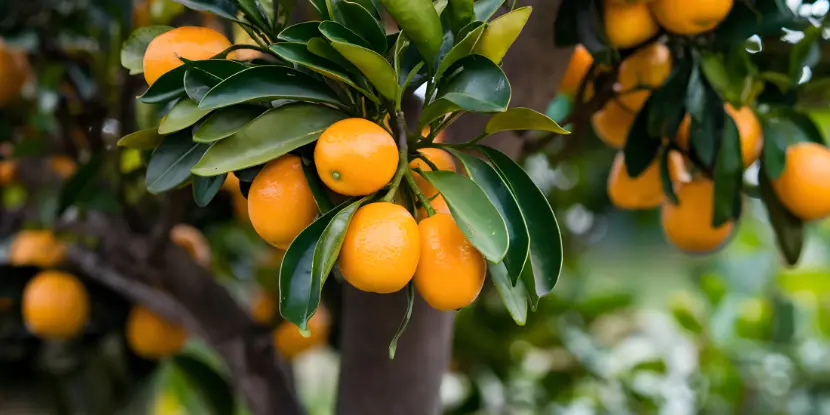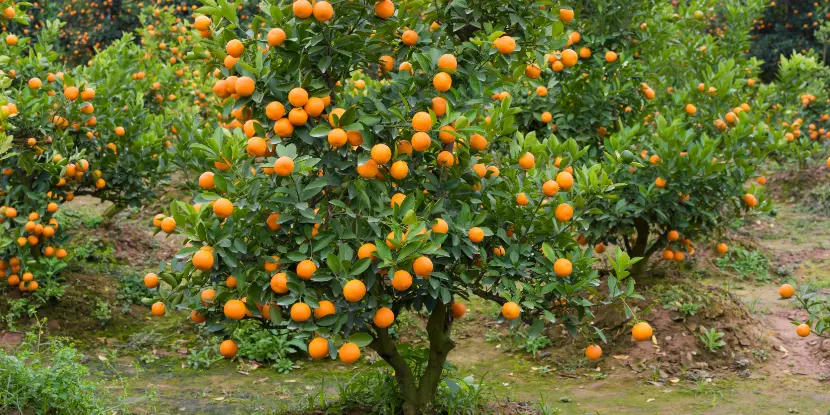Do you love oranges but hate peeling them? Do you favor limes but hate juicing them?
Then maybe the kumquat is for you.
The kumquat’s edible skin is surprisingly sweet and fragrant, contrasting with the tart, tangy juice of the flesh. It’s a citrus aficionado’s dream! And you can eat a kumquat peel and all!
Native to Southeast Asia, the kumquat was first cultivated over 3,000 years ago in China. It was introduced to California in the mid-19th century. The name “kumquat” comes from the Cantonese word gam gwat, which translates to “golden orange.”
The tree flourishes in warm regions, where it’s both a decorative plant and a source of tasty fruit.
What Makes the Kumquat Tree Special?
- Kumquat trees are evergreen, bearing lush foliage all year.
- Trees typically grow only 6–10 feet tall, making them an excellent choice for small gardens or containers.
- A single tree can produce a significant amount of fruit.
- Kumquats are one of the most cold-tolerant citrus trees, enduring temperatures as low as 20°F.
- Eat them whole — the peel’s sweetness pairs with the pulp’s tang, creating a mouthwatering balance.

Kumquats are delicious in jellies and marmalades and as salad accents.
Optimal Growing Conditions
Light
- Kumquat trees need 6–8 hours of full sun daily.
- Choose a sunny spot that maximizes exposure, such as a south-facing yard or balcony.
Temperature
- Kumquats trees thrive in temperatures between 50°F and 85°F.
- The trees can survive mild frosts, but prolonged exposure to freezing temperatures can damage them.
- Consider protective covers during occasional winter cold snaps.
Soil
- Kumquats prefer well-draining, slightly acidic soil with a pH between 5.5 and 6.5.
- If you’re planting in a pot, use a high-quality citrus mix.
- For in-ground planting, loosen the soil and add organic matter if needed.
Propagating Your Kumquat Tree
Propagating through grafting ensures a strong rootstock and healthy fruit production. While growing from seeds is possible, it can take years — sometimes up to 10 — to see fruit, and the quality may not match the parent tree.
Steps for Grafting a Kumquat Tree
- Choose a rootstock compatible with kumquats. The rootstock should be at least the thickness of a pencil.
- Cut the rootstock horizontally using sharp, sterilized pruning shears. Create a vertical slit about 1–2 inches long to form a “T” shape for grafting.
- Select a scion (a branch or bud) from a healthy kumquat tree with desirable fruit characteristics. Ensure the scion is of similar thickness to the rootstock and has multiple buds.
- Trim the bottom end of the scion into a wedge shape that fits snugly into the slit on the rootstock. Clean, precise cuts are essential to promote successful cambium layer alignment.
- Insert the scion into the slit on the rootstock, ensuring the cambium layers of both pieces align as much as possible. Proper alignment is crucial for the graft to take.
- Securely wrap the graft union with grafting tape or a rubber band to hold the scion and rootstock in place. This prevents movement and protects the graft from drying out.
- Apply grafting wax to seal any exposed areas and protect the graft from moisture loss and pests. Ensure the entire graft site is covered.
- Place the grafted tree in a protected environment with adequate sunlight. Water regularly, but avoid overwatering.
- Monitor the graft site for signs of growth and gently remove the tape once the graft has fully healed.
Or, if you prefer, you could buy a young kumquat tree from your local nursery. It’s easy and reliable!
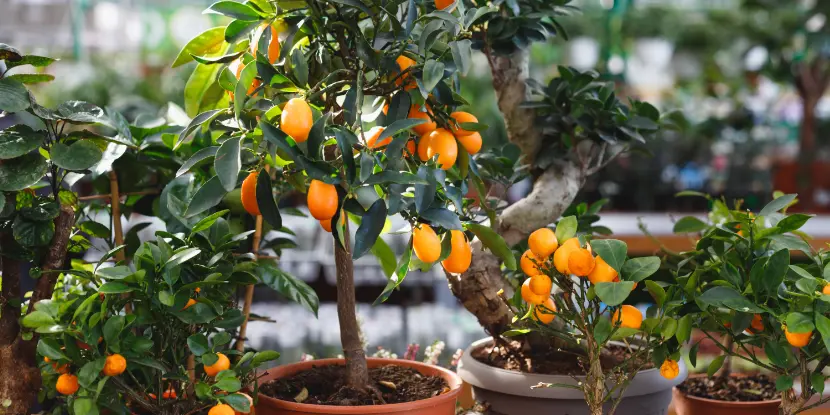
Kumquats are small trees that can easily be grown in containers.
Planting Your Kumquat Tree
- Select a spot that receives full sunlight for at least 6–8 hours a day and has well-draining soil. Avoid areas prone to waterlogging.
- Test the soil pH to ensure it’s slightly acidic, ideally between 5.5 and 6.5. If needed, amend the soil with compost or organic matter to enrich it and improve drainage.
- Dig a hole twice as wide and slightly deeper than the root ball of your kumquat tree. This allows the roots to spread easily and promotes healthy growth.
- Gently remove the kumquat tree from its container, being careful not to damage the roots. Set the tree in the hole so that the top of the root ball is level with or slightly above the surrounding soil.
- Refill the hole with the excavated soil, lightly tamping it down to remove air pockets. Be careful not to compact the soil too much, as this can impede drainage and root growth.
- Give the tree a deep watering immediately after planting to settle the soil around the roots and reduce transplant shock.
- Apply a 2-3 inch layer of mulch around the base of the tree, keeping it a few inches away from the trunk. Mulch retains soil moisture and regulates soil temperature.
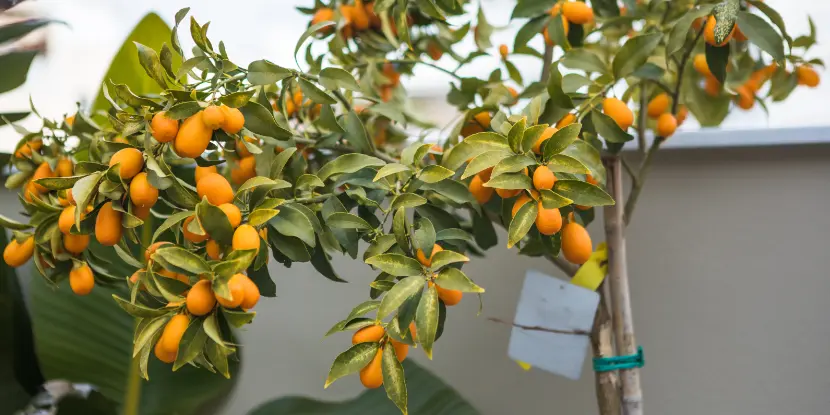
A young kumquat tree staked for support.
Kumquat Tree Care
Water
- Water young trees 1–2 times per week to keep the soil moist but not soggy.
- For mature trees, aim for deep watering every 7–10 days, adjusting for temperatures and rainfall.
Fertilizer
- Feed your kumquat tree with a citrus-specific fertilizer rich in nitrogen and micronutrients every month during the growing season (spring through early fall).
- Reduce feeding in winter when growth slows.
Pests & Diseases
Common problems for kumquat trees include:
- Aphids and whiteflies, which can be managed with neem oil or insecticidal soap.
- Scale insects, often treated with horticultural oil.
- Root rot caused by overwatering and poor drainage. Always ensure soil is well-draining!
Pruning
- Focus on removing dead or crossing branches in late winter or early spring.
- Regular light pruning helps maintain shape and encourages airflow within the canopy.
Harvesting Kumquats
Kumquat trees typically begin bearing fruit within 2–3 years of planting (if grafted). The exact timing depends on the variety, but in Southern California, kumquats are harvested between late fall and early spring.
How do you know they’re ready? Ripe kumquats will be vibrant orange and slightly firm to the touch.
Harvesting is simple — just twist the fruit gently or snip it off with pruning shears.
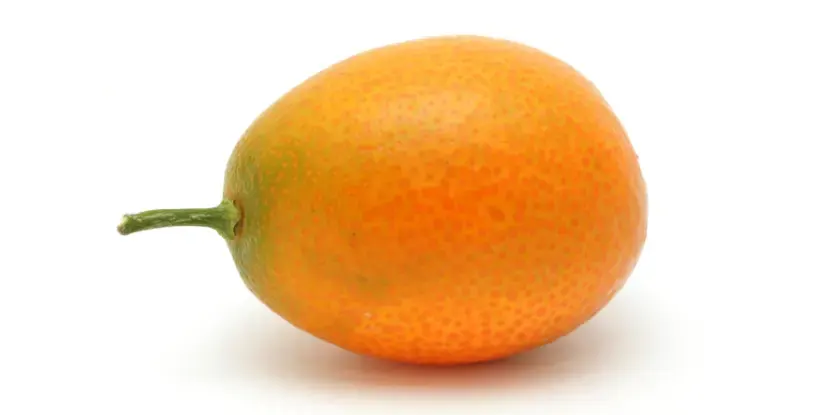
Closeup of a kumquat fruit with attached stem.
FAQs: Kumquat Tree Care
Q: How tall do kumquat trees grow?
Most kumquat trees grow between 6–10 feet tall, making them perfect for small spaces.
Q: How long does it take for a kumquat tree to produce fruit?
If grown from a grafted sapling, expect fruit within 2–3 years. Seed-grown trees can take 7–10 years or more to bear fruit.
Q: What’s the best variety for Southern California?
The Nagami kumquat is popular for its savory flavor and productivity in California’s climate.
Q: Are kumquat trees self-pollinating?
Yes, kumquat trees are self-pollinating, so you only need one tree to produce fruit.
Q: Can I grow kumquats in containers?
Yes. Their compact size makes them an excellent choice for pots. Just ensure the container has good drainage and is at least 15–20 gallons.
Q: Do kumquat trees lose their leaves?
No, kumquats are evergreen, so they retain their leaves year-round unless stressed.
Q: What’s the typical lifespan of a kumquat tree?
With proper care, kumquat trees can live and bear fruit for 50 years or more.
Q: Can I eat kumquats straight from the tree?
Yes! Rinse them off, and enjoy them whole — peel and all.


